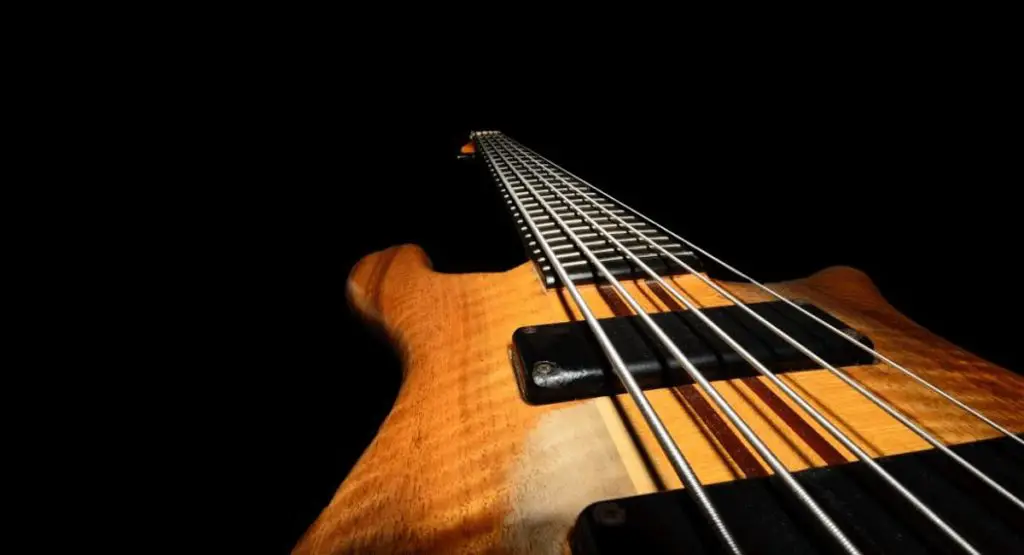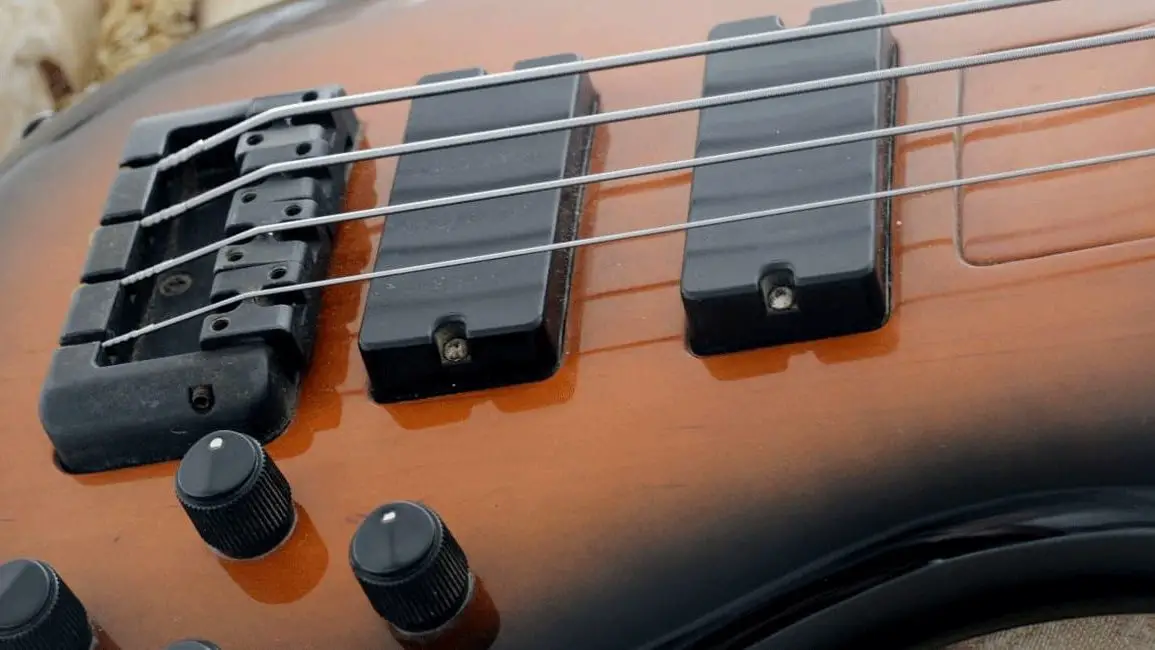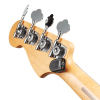If you are a bass player, you will enjoy reading this article. As you decide on the type of bass to progress with, depending on your playing style, get complete knowledge on 4 string vs 5 string basses and see which one best fits your needs.
The bass guitar is a musical instrument used in a wide array of music styles, from Leo Fender to Paul Tutmarc.
Let’s learn what use is the addition of the rotund low-B string to the original E-A-D-G. Whether you are a professional bass guitarist looking to make a change and improve on your skill or a part of the cool crowd of beginner musicians, dig in.
4 String vs 5 String Bass: A Summarized Answer
A 4-string bass is easy to grasp and does well in most music genres. On the other hand, the 5-string requires more effort to control because of the additional 5th string, which gives access to lower notes that would be difficult to replicate just as clearly and easily on the 4-string bass.
4 String vs. 5 String Bass Guitar: Know the Basics
4-String Bass
The four-string bass was the typical bass guitar right from when Tutmarc unveiled his Model 736 Bass Fiddle in 1935, having the strings E-A-D-G. It remained so until the 1970s when the relatively low B-string was introduced and the bass guitar door into string variety was opened.
A 4-string bass guitar is a musical tool that contributes to different parts performing their function. These parts include; scale length, weight, neck width, the string themselves, neck profile, and space between strings.
Some guitar shops, if not all, will have a lot of four-string bass guitars. This percentage is not due to any other factor other than its versatility right from invention and continued by the birth of the Fender bass. A lot of songs have been made within that range, so it has always proven sufficient.
Amazing bass players include Stanley Clarke with his alembic short-scale bass, who adopted the 4-string bass because of the versatility of this instrument and their undying dedication to perfecting the craft.
5-String Bass
The five-string bass guitar was introduced in the 1970s, independent from the existing four-string. It was used to create more range for players who wanted to go lower and utilize those additional notes in their music. Examples include legends like Nathan East with his BB5000 5-string bass in the 1980s.
Musicians whose genre of music did not need the lower notes to ennoble the style simply stuck with their trusty steed. The extra string added was the burly low B-string which produced five new notes 0B, 1C, 1C♯, 1D, and 1D♯ when properly tuned.
The extra string required bass guitar manufacturers to create a structure that would house it. There were now bass variants with alternative bass tones to use.

Let’s learn about the pros and cons of 4 string vs 5 string bass.
Pros and Cons of 4-String Bass
Pros
- Easy to learn: four strings are less cumbersome. You have four strings to master and work with
- Less expensive: there are three types of bass guitars, and of these three, 4-strings are easy to get from guitar shops around
- Narrower neck: the guitar neck serves as the platform on which the strings are affixed, so four strings will minimize the space used. Plus, a narrow string fretboard on a 4-string bass guitar’s neck helps with the efficient movement of hand and grip
- Easy fit: 4-string basses are straightforward to work with, especially for sound engineers
Cons
- Time-consuming: it takes more time to make music. With the tune-downs, you would have to carry out to access lower keys for your music
- Limited Low Range: there are four strings. Despite this limitation, bass players have been forced to tune down and get pitches that they can work with. But tune downs can only do so much, and tunings are detrimental to a bass guitar’s string
- Less efficiency: you may end up moving your hand around a lot attempting to control certain chords
- Tunings: tune down gradually spoils the tuning pegs, the string too, and impede the creative process. You have to see it as forcing the bass to do what it has not been programmed to do. Of course, it will deliver some of those notes you want, just not as clear or as smooth
Pros and Cons of 5-String Bass
Pros
- Lower Range: this is its best asset. The fifth string carrying the low-B gives access to such low-end notes you would feel them reverberate through you when played. This is a great advantage compared to the 4-string bass because to access these lower notes, much tuning is needed, and still, it would not sound right
- String Durability: if you use the standard tuning, your strings are guaranteed to last longer. Constantly tuning a guitar generally weakens the strings in use
- Less Tuning: the 5-string just requires fewer tune downs to hit a particular note or play other keys. All that stress is removed because you can play with the standard tuning
- Dexterity: with this bass guitar, a music enthusiast loving many types of music can adapt the bass sound to many other options. This can be achieved with standard tuning, even more, versatility is accessed with a bit of tune down. The low-B carries an extra five notes, just for emphasis’ sake
- Efficiency: playing a complicated lick that would end at a fret on a different string from where you started, will require quick and very efficient movement of hands. Achievable on a four-string, but only after long practice to get a smooth flow. This is easily done since an extra string will carry the same note on a fret and string closer to your position
Cons
- Complexity: with an additional string, you are required to manage and control more parts. Since you would use it in a lick and need to shut it out when unnecessary
- Weight: additional strings require manufacturers to design a body to bear that string, especially with thicker and broader necks. This makes the bass guitar heavier
- Expensive: a design has to be developed by bass manufacturers, and more materials have to be used to animate said design, so of course, consumers have to pay more
Starting Your Bass Career: Things to Know
Expenses
You are undertaking a new goal, and as much as it requires your dedication and focus, this particular goal will incur costs. It would help if you considered how much you are willing to spend on acquiring the bass guitar to learn.
Bass Guitar Necks
This will depend on your ability to wrap your hand around the neck of the guitar and how comfortable you would be with it. A thicker or thinner has pros and cons, but these are dependent on the user. What you should expect from a more delicate neck, for example, would be a narrower string spacing and a narrower fretboard.
Bass Guitar Body
Consider the bass guitar body material. The type of wood used will affect its weight, durability, exterior feel, and even sound in slap bass. Some types of wood are ash wood, mahogany, dense wood, and alder.
Final Thoughts
You would probably learn faster using a four-string bass, and it is the simplest of all bass guitar types. Wrapping your head around five strings might inhibit you from grasping the basis of bass guitar playing.
For some beginners, 4 strings may be unsuitable due to lower ranges. For such bass players, an additional bass string is essential to achieve their goals.
Whatever decision you eventually make should be unique to your project or plan. This 4 string vs 5 string bass article is meant to guide you to make the best choice for your music.



